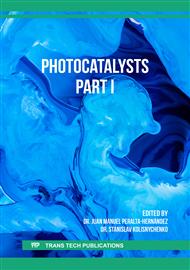p.3
p.10
p.17
p.23
p.31
p.38
p.47
p.57
Visible-Light Sensitive Photocatalytic Activity of FeOx- and P-Modified TiO2 with Rutile Structure
Abstract:
Nanocrystalline rutile TiO2 particles were prepared via hydrothermal treatment of Ti-containing precursors obtained by low-temperature aging for a transparent diluted HCl solution of amorphous TiO2. The products were modified with FeOx and phosphoric acid, and the photocatalytic activities of the obtained catalysts under visible-light irradiation were examined. By the addition of FeOx or phosphoric acid, the photocatalytic activity of the rutile TiO2 was slightly increased. On the contrary, by the FeOx loading and subsequent addition of phosphoric acid, significant increases in the photocatalytic activity were attained. Results of UV-vis suggest that the iron oxides formed on the surface of rutile TiO2 were changed into highly dispersed iron phosphate species by the addition of phosphoric acid. It was presumed that these species effectively suppress the recombination reaction between the photogenerated electrons and holes and contribute to the high photocatalytic activity of the rutile TiO2 photocatalysts modified with FeOx and phosphoric acid.
Info:
Periodical:
Pages:
23-27
Citation:
Online since:
November 2020
Authors:
Price:
Сopyright:
© 2020 Trans Tech Publications Ltd. All Rights Reserved
Share:
Citation:



